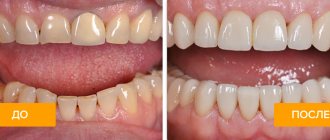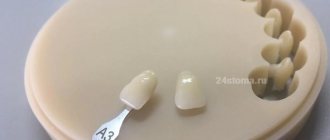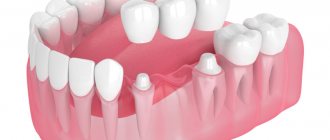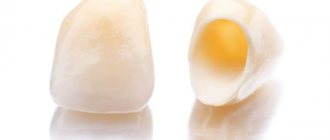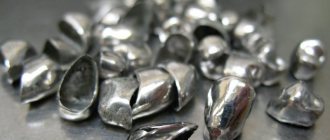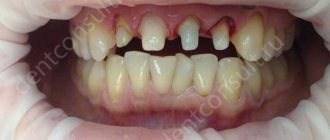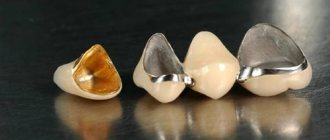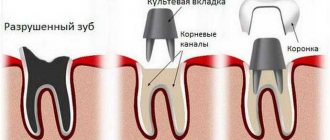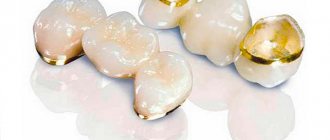- What is implantation
- Which doctor performs the procedure
- Indications and contraindications
- Features of the procedure
- Possible complications
- In conclusion
Modern dentistry now has enormous capabilities not only for treatment, but also for dental restoration. Among dental procedures, the installation of implants now occupies a leading position. Many people think about this operation, but most have questions: who does dental implantation and what are the features of the procedure. Such information is necessary in order to avoid receiving poor-quality services and possible further complications when choosing dentistry (often arise if implantation is carried out by an unqualified specialist).
What is a dental crown
A crown is a type of dental prosthesis, non-removable, completely or partially covering the visible part of the tooth. Sometimes it is part of a larger prosthesis, such as a bridge. Crowns are distinguished:
- orthopedic. Replenish the missing part of the tooth crown. These include equatorial, three-quarter (for premolars), half-crowns (protect part of the vertical surface and the cutting edge);
- full clinical. Like a cap, they cover the entire stump of the tooth.
- stump, fenestrated, crowns with a pin are placed when more than 80% of tooth decay occurs, so they are often classified as pin structures.
To ensure that the crown does not interfere with the closure and active movement of the jaw, it is made according to the shape of the tooth, with a tight coverage of the neck without immersing more than 0.2 mm in the gum pocket. “Parts” for this type of fixed prosthetics are cast from metals, alloys, porcelain, and plastic. There are combined dentures, when a material different from the base is used for lining.
An inlay is first installed under the crown. Happens:
- straight (direct), made in the mouth, used when the tooth has 3 out of 4 walls left. Externally, it is a screw or pin that is inserted into the canal with a filling;
- indirect (indirect), an impression is made, and the inlay is cast from it in the laboratory.
The pin cult inlay is considered more reliable (and expensive); a ceramic inlay is placed under ceramic dentures.
Dental crown
What does orthopedics do?
Orthopedic dentistry is a broad area of medicine responsible for the prevention and elimination of damage and defects of the maxillo-speech apparatus. Specialists working in this field carry out different types of dental prosthetics:
- supported by metal implants;
- bridges;
- dental crowns;
- ceramic inlays;
- veneers;
- removable orthopedic prostheses.
Is it possible to do an MRI with crowns?
Orthopedic dentistry restores the integrity of the dentition and the aesthetic beauty of the smile. Modern methods make it possible to correct serious damage and preserve the health and natural appearance of the teeth of adults and children.
What are the tasks of an orthopedic dentist?
Thinning enamel, chips, and carious cavities require urgent treatment. Otherwise, the functionality of the jaw is impaired, the bite worsens, and the gums become inflamed. A dentist whose specialty is orthopedics performs important tasks. His job is to diagnose, select a prosthetic method and restore damaged teeth.
The orthopedist’s task is to diagnose, select a prosthetic method and restore damaged teeth.
After a mandatory examination, the orthopedist offers different methods of restoration. Depending on the extent of the damage, these may be:
- minor correction with ceramic inlays;
In what cases is a crown placed on a tooth?
Purpose of artificial crowns:
- replenish lost tooth tissue;
- restore its damaged surfaces.
They are made when it is impossible to restore a tooth by filling or placing inlays, i.e. it has already been destroyed by 60% - 80%. Protective “caps” are used for certain diseases of the jaw, oral cavity, and soft tissues. For example, with arthrosis of the TMJ, a prosthesis is indicated to protect teeth from abrasion (wear) while restoring the size of the jaw opening.
Crowns are also retaining elements that secure bridges or removable dentures; they can level the surface of incorrectly positioned teeth with congenital defects of hard tissues (hypoplasie). Quite often, dentures are used to cover stained, discolored teeth due to caries and teeth with or without dead pulp.
Indications for tooth replacement with artificial crowns:
- Pathology of hard tissue, spreading over an area of 50 to 80%: caries;
- wedge-shaped defects (for example, a part broke off as a result of injury);
- pathological abrasion, for example, due to pathological clenching of the jaw (bruxism);
- hypoplasia (congenital anomaly, partial or complete absence of enamel);
- fluorosis (softening of hard tissues due to excess fluoride);
- erosion (destruction of enamel and dentin).
Dentist surgeon
One of the most difficult specializations in dentistry is surgery. Doctors perform surgical interventions during the treatment of diseases and help eliminate defects that worsen a person’s appearance. A dental surgeon performs a wide range of services:
- removes teeth;
- treats dislocations of teeth and joints;
- performs jaw surgery;
- eliminates stomatitis, pulpitis, gingivitis;
- neutralizes the infectious process;
- removes the consequences of injuries and congenital defects of the oral cavity.
Often, a prosthetist combines practice with surgical activities.
The surgeon, in tandem with the orthopedist, prepares the jaw for prosthetics, inserts and removes implants.
Contraindications for installation
The main contraindication to the use of a fixed prosthesis is considered to be poor oral hygiene. Over time, plaque may form around the “cap,” which damages the periodontium and intensifies caries. Therefore, first, teeth are cleaned, damaged teeth are removed, carious cavities are filled, and foci of inflammation are treated. Only then can the crown be installed.
Temporary contraindications also include:
- age up to 16-18 years (individually, they look to see if the jaw continues to grow and the roots of the teeth continue to form);
- severe health condition (heart attack, ischemia, hypertensive crisis).
Absolute contraindications:
- Completely healthy teeth (intact), when they do not serve as support for devices or dentures.
- Pathological tooth mobility of the 3rd degree (mobility with an inclination, the tooth can rotate 360 degrees).
- Incurable infection in the periodontal area.
Which doctor performs the procedure
In the majority, people believe that a dentist is a generalist doctor who alone performs absolutely any procedure in this field of medicine. This is not at all true; in dentistry there are several areas where doctors of a certain specialization work.
Of course, one doctor can have several specialties, however, for example, to perform surgical operations (including implantation) requires appropriate qualifications.
So who puts implants? Which specialist should you contact if you need a service?
The first appointment is most often carried out by a dentist in the therapeutic department to determine the indications and prescribe diagnostics. If the patient has no contraindications, and the need for implantation is confirmed, then a day of surgery is scheduled, which will be performed by a doctor with experience in installing implants and prosthetics. Which doctor performs dental implants? Popularly, such a doctor is called an implantologist; in medicine, a surgeon or orthopedist.
Which crown is better to put?
Based on the materials used, the following types of crowns are distinguished.
Sitall
Crowns made of glass-crystalline materials are biologically inert, i.e. do not cause adverse clinical manifestations. Dentures resist the chewing load well, are quite elastic, and have increased resistance to the corrosive effects of aggressive agents. The main disadvantage is fragility. Recommended for allergy sufferers and chronically ill people (due to the consumption of a large number of medications, they should avoid anything that can provoke an allergy or cause a rejection reaction).
Porcelain (ceramics)
Standard porcelain “caps” are made with a stably fixed or separate metal pin (the second option is more convenient). A more expensive option is custom-made prostheses based on a platinum matrix. After 2 annealings, a stage of shape correction between them, the individual characteristics of the teeth (cracks, stains) are imitated on the surface. Then they are tinted with majolica glazes, securing with another annealing. Then the “cap” will look natural.
Porcelain crowns
The main disadvantages of porcelain fixed dentures:
- fragility;
- poor marginal fit;
- abrade the surface of antagonist teeth.
They are chosen by people who have high aesthetic requirements for the oral cavity (show business). Ceramic dentures are also used for those who cannot undergo restoration with a composite. If the occlusal load is distributed unevenly, the dentist will suggest a different material.
Metal
More than 500 alloys are used in dentistry, but most metal fixed dentures are made of chromium-nickel or silver-palladium alloy, as well as 900 gold with the addition of copper, silver, and platinum as a ligature.
Metal “caps” are resistant to alkali and acid (in small concentrations), have high wear resistance, are moderately elastic, and are relatively biologically indifferent. The fashion for the “gold tooth” is back. Metal prostheses are durable products that do not require special attention. The retention time of the properties of a metal crown depends on the alloy.
Zirconium dioxide
These are the most popular of all fixed types of prostheses. Zirconium oxide (or dioxide, in the formula there are 2 oxygen molecules per molecule of zirconium) is chosen by public figures. The process of making a “cap” is labor-intensive, using computer modeling, so the product is expensive. This is a category of elite prosthetics.
The crown is durable, its color and transparency are very similar to a real tooth. In terms of all the characteristics of medical implants (bioinertness, resistance to acid-base influence, elasticity) it is one of the best.
There are 2 types of crowns:
- with the application of ceramics, when metal is used as a base;
- without porcelain, then the desired shade is manually applied to it.
Advantages of zirconium fixed prostheses:
- Making fairly thin crowns with minimal grinding (this way the teeth remain alive).
- Accuracy of fit (computer modeling is used).
- The service life of crowns is from 10 to 20 years.
- High aesthetics. In terms of transparency and structure, they best match natural teeth.
- Strength. They are made for both front and chewing teeth.
- Biocompatibility.
- High precision in the manufacture of crowns allows you to achieve the tightest possible fit, avoiding the inflammatory process and the development of caries.
Metal ceramics
This is a good alternative to porcelain crowns, since metal-ceramic prostheses are characterized by:
- increased strength;
- better fit at the edges.
Metal ceramics
A metal alloy is used for the base, and a ceramic mass is applied to it. The best base is gold, in which case the base is thin, freeing up more space for ceramics. The metal will not show through the porcelain - this makes your smile look more natural. But there is a nuance: it is highly undesirable to install several fixed dentures (or a base with ceramics) made of different metals. For installation, deep preparation is used only on the vestibular surface (this is the side of the tooth turned towards the lips and cheeks) to mask the frame of the prosthesis.
Contraindications for installation:
- Teeth with thin crowns, when there is a risk of pulp damage.
- Deep blocking or wearing away bite.
- Pathological abrasion of tooth tissues.
- Parafunctions of the masticatory muscles, in which there is high muscle excitability, bruxism, and lateral displacement of the jaw.
Please note: it is better to avoid metal-ceramic crowns if you have marginal periodontal diseases, because Patients regularly experience functional overload of teeth, which leads to exacerbation of inflammation and deepening of the destruction process.
Metal-plastic
The second name for “caps” is combined, because Composed of plastic, composite, porcelain. These are temporary “caps” since the service life usually does not exceed 3 years. Plastic deteriorates over time under the influence of acids and alkalis, and can be colored with natural food dyes (wine). Summary: not bad, as a temporary option (there are situations, for example, injury, accident, but tomorrow you need to speak, be at negotiations).
Plastic
With good aesthetic properties, a plastic fixed prosthesis is inferior to its analogues in strength. It is not used to restore thin or flat incisors, with a deep or receding bite, pathological abrasion of teeth, or some dentition defects. This type of crown should not be placed on people with allergies.
Fixed dentures are made in 2-3 layers on an interpenetrating polymer mesh. They are recommended for prosthetics for children, during the correction of dentoalveolar anomalies, during periods of primary and mixed dentition.
Temporary crowns made of plastic
All
Fixed prosthetics
- Crowns
- Metal-ceramic crowns
- Metal-free crowns
- All-ceramic crowns
- Crowns based on zirconium oxide
- Temporary crowns
- Microprosthetics (tabs)
- Veneers
- Hollywood veneers (Lumineers)
Removable prosthetics
- Complete removable dentures
- Partially removable dentures
- Partially removable dentures made of plastic
- Clasp dentures
How to install crowns
Let's look at the stages of installing a crown on a tooth in more detail.
Diagnostics
Before making a fixed denture, a clinical evaluation of the tooth is performed. Using a dental mirror, tweezers and a probe, the doctor:
- determines the degree of crown destruction, the severity of the equator:
- records the presence of seals;
- determines the relationship of the prosthetic tooth with adjacent teeth and antagonist teeth;
- studies the condition of the periodontium and the degree of tooth mobility.
To exclude contraindications (neoplasms, inflammatory processes), the dentist may also refer the patient for an x-ray.
Preparing for installation
The tooth under the denture should be as healthy as possible, i.e. cleared of plaque, caries, sealed if necessary, and the inflammatory process is eliminated. In this case, the dentist may recommend removing the nerve, but the tooth without the nerve dries out under the prosthesis and becomes less durable. Underneath it, even with perfectly filled canals, 1 in 10 (statistics from The American Dental Association (ADA)) develops an infection in the periodontium. Over time, pain will appear in this place, the “cap” will begin to dangle, and secondary caries will develop underneath it.
Remember: the doctor must do a cold test on the nerve (usually a cold stream of water is used for this). The nerve is removed if the pain does not go away after a few seconds.
After removing the nerve and filling the canals, everything unnecessary is removed from the tooth (pin, fillings, caries). The thin walls are shortened, forming a platform for the inlay, and the edges of the treatment are smoothed so that they do not scratch the tongue or cheek when the inlay is installed. When turning, the tooth is given the shape of a cylinder, and the cavity inside is oval-shaped - this increases the reliability of fixation of the inlay.
Grinding a tooth for a crown
Taking an impression, choosing a color
To obtain an impression use:
- standard impression trays with perforations to hold the impression material in the tray;
- impression materials (for example, Algmat).
The taken impression is called a “negative”. When it is cast with hard plaster, they will receive a “positive” - an exact model of the teeth.
An inlay pin is placed in the prepared tooth, then an imprint is taken using silicone mass (always together with adjacent teeth). Another impression is made of the entire jaw and antagonist teeth. Quality criterion: the impression must accurately reproduce the position of prepared and unprepared teeth, the relative position and distance between them, as well as the position of soft tissues.
The average production time for an inlay is a week. Before cementing the inlay, the pins are cut to the same level as it. They try the inlay on the tooth, check the tightness of the fit, and then cement it. It is clear that this is not construction cement, especially not a cement mortar with sand. This is a special glass ionomer cement for dentistry.
After 20-25 minutes, the excess is removed, a retraction thread is laid around the perimeter of the tooth to slightly move the edge of the gum. Then in the future the “cap” will not hang over the gum. Then the tooth is polished and smoothed again so that the fit of the fixed prosthesis is as tight as possible and the remainder of the tooth is not destroyed. A silicone impression is then taken to create the crown.
Temporary composite “caps” are made that will protect the gums until the next visit. They are installed with temporary cement. Now you can choose the color of the future prosthesis.
To do this, they use a “color key”, which contains on average about 15 samples. The sample is compared with the teeth, choosing the color closest to them in daylight, neon and artificial light (!). It is better to meet with a technician for this, because... a real tooth has a color transition from light to dark, more transparent at the edges. Only a technician can correctly determine:
- color;
- tonal ratio (light – dark);
- color intensity (saturated – pale);
- color (yellowish – reddish).
They come to the dental technician without makeup, wearing uniform, gray clothes.
Crown making and fitting
In a modern dental clinic, crowns are made using the best impression materials and computer modeling, so there is no fitting stage. If the clinic is budget (but this does not mean that bad doctors work there), or several prostheses are made, fittings are carried out. To put a “cap”, it is placed on temporary cement and the quality of work is checked.
Making crowns
Installation
The tooth is cleaned of the remains of temporary cement, a retraction thread is laid so that when the “cap” is installed, moisture does not get on the tooth. They place a crown on the tooth and check the tightness of the edges. They are fixed with cement (the excess is, of course, removed).
The quality of the installation is checked using dental floss: it should pass between the teeth under tension and make a loud click. Then food remains will not remain between the teeth.
How to place crowns on implants
Installing a crown on an implant is slightly different from installing a crown on a tooth; it is recommended for severely damaged teeth. After diagnosis, the dentist prepares the oral cavity for implantation. This is a titanium alloy screw that is screwed into the bone. It has a conical head that imitates a tooth. This is where the “cap” will be put on.
Just like with conventional crowns, the inflammatory process and caries are first treated. Then an implant is installed into the bone or tooth root (an anesthetic injection is given first), which will take root in 5-6 months.
Please note: as the healing time decreases, the risk of implant failure increases.
Next begins the stage of installing gum formers, which are required for uniform growth of soft tissue around the implants, taking into account future crowns. Impressions for dentures are removed after 2 weeks. First, using a dental key, the formers are removed and transfers are installed, which will remain in the impression and become the basis for attaching the implants.
An impression is taken using silicone impression material, as when installing conventional crowns. Then a plaster model is cast. While the crowns are being made, the cone is again covered with a former. The role of the gasket when installing the prosthesis on the implant is performed by the abutment. It is screwed on with a screw, and the head is isolated with a temporary filling before installing the “cap”. The crown itself is secured using glass ionomer cement. Read more about different types of implantation here.
What determines the quality of prosthetics?
Advertisements that litter the Internet tend to focus on materials. For example:
- “Metal ceramics for 3,900 rubles!”
- “Zirconium crowns for 5,000 rubles, subsequent tooth extraction is free!”
- “Removable denture for 10 thousand”,
and so on.
Meanwhile, the role of materials in the quality of manufactured prostheses is greatly exaggerated. Ordinary metal-ceramic crowns can be made more aesthetically pleasing than ceramic ones, and they will be very different from each other, because it depends on who made them and how.
Let's show a simple example:
Therefore, we would highlight the “quality triad” - three components that determine how functional, aesthetic and durable your new teeth will be:
Total, by points:
- original components are necessary primarily for implant prosthetics. Now, for almost every implantation system, Chinese counterfeits are produced, and with the increase in the accuracy of digital milling machines, doctors and laboratories have the opportunity to produce the same abutments almost on the knee.
However, no one is yet able to replicate the original dimensions and alloys (the latter is important to avoid galvanism and corrosion). Therefore, all manufacturers of implantation systems will void the warranty if, during the examination of the doctor’s joint, any left-handed screw or abutment is found. Our dental center CLINIC IN works directly with the world's largest manufacturer of implantation systems, Dentsply Sirona Implants, we do not need to use counterfeit products to save money. Therefore, all our work, all original components we use, are covered by the manufacturer’s warranty. You can read more about this here>>. - highly qualified dental technician and well-equipped dental laboratory. Indeed, it is unlikely that we can offer you digital technologies if our laboratory does not have special equipment and trained personnel.
In addition, each dental crown, each prosthesis is, in fact, a piece of art - and the extent to which the dental technician masters this art will depend on the aesthetics of the final product. Making highly aesthetic dentures is a unique fusion of art, good taste and engineering. And, unfortunately, few dental technicians can offer a job worthy of you. And those who are, as a rule, are in great demand, so they ask for a lot of money for their services. Through a lengthy search and a very strict selection, our orthopedic doctors, David, Kirill and Ivan, selected four dental laboratories from thirty candidates, the quality of which would suit us and our patients. Yes, such work is not cheap, but you will never guess the artificial teeth in the smiles of our friends. We will definitely tell you about our partner laboratories in one of the future articles, since the manufacture of dentures is a very interesting and extensive topic. - a medical specialist is, in a way, the chief architect of any dental rehabilitation. His task includes not only preparing teeth and implants for fixing restorations and prostheses, but also managing the entire process of patient treatment - it is the orthopedic dentist who determines the placement scheme of implants, together with the dentist-therapist makes a decision on the preservation/removal of teeth, and gives recommendations on the form and the color of future crowns, and in some cases models them independently. Their service life largely depends on the orthopedic dentist’s understanding of the rules of prosthetics on implants, so when planning implantation, he is always somewhere nearby.
Our dental center employs highly qualified dental specialists who have undergone rigorous selection and testing with fire, water and copper pipes.
They can handle prosthetics of any complexity and any option, no matter what you choose. But, most importantly, they understand and accept your wishes, take into account your characteristics and needs, they restore YOUR teeth, not their own, so all their experience, all their competence and all their arsenal of means are aimed at achieving only one goal - you must like the result, first everything, to you. Chief's comment: The ability to hear and understand your patient is perhaps the main quality for a dentist involved in the aesthetic and functional rehabilitation of a smile. In the end, if function can be calculated and adjusted, then aesthetics is a subjective and individual concept for each of us. Just as there are no specific standards of beauty, there is no one generally accepted idea about the aesthetics of a smile. It’s the task of our doctors to figure this out and take into account what you need. It is their direct responsibility to realize what you want without loss of functionality, durability, reliability and comfort. That is why such doctors work for us.
What to do after the procedure
The time during which you cannot eat after a crown is installed depends on the type of cement. In addition, anesthesia is still in effect, and you can accidentally injure yourself. It is better to refrain from eating for 2-3 hours.
It is not recommended to load the side where the crown was installed - chew on the opposite side. Drinks and food with coloring pigments (red wine, berries, seasonings) should be kept to a minimum. It is recommended to avoid:
- sudden temperature changes (for example, drinking ice cream with coffee);
- solid food (bones, cartilage, nuts);
- sticky foods (taffy, some oriental sweets).
Hygiene requirements are standard: cleaning the mouth in the morning and evening. Superfloss, dental brush, and irrigator are recommended for bridges.
Rehabilitation period
If necessary, the doctor will prescribe medications and painkillers. It is equally important to follow a number of rules for the first 3-4 days that will prevent the development of complications:
- Do not rinse your mouth.
- Do not chew or brush your teeth on the extraction side.
- Do not take a hot bath or visit a bathhouse or sauna.
- Do not engage in sports or heavy physical labor.
- Avoid air travel (especially if the operation was on the upper jaw).
2-3 days after removal you should come for a follow-up examination, and after 5 days the sutures are removed.
To the list of posts
Does it hurt to get a crown?
The presence of a pain symptom during installation of a crown on a tooth depends on the tooth:
- on the pulpless one the pain is not felt. However, if you ask for additional anesthesia, they will give it;
- on “living” teeth, with the root preserved, there is an unpleasant sensation, pain is felt during grinding. Anesthesia solves the problem, but it is advisable to do a test to avoid an allergic reaction.
When installing dental crowns, when a temporary prosthesis is installed, the edge of the gum may be damaged and discomfort may be felt, but this is a normal process - no medications are required. If there is increased nervous excitability, the pain threshold is low - you can take sedatives and painkillers (be sure to discuss this issue with your dentist!).
Who does prosthetics and dental implants?
If you are interested in which doctor places dental crowns, then know that this is done by an orthopedist - a doctor of narrow specialization who can combine his function with another dental specialty. Often, a prosthetist combines practice with surgical activities, since the installation of many prostheses requires surgical intervention.
The services of an orthopedic surgeon are in demand to implant an artificial root into the bone, install an abutment and fix a crown on it. Implantation is a serious intervention that requires a comprehensive diagnosis of the mouth. Based on the results, the specialist develops a prosthetic plan and makes impressions for the crown.
Possible complications after the procedure
Complications are rare after crown placement, but complications do occur. Most often this is a medical error or lack of professionalism. Therefore, the best prevention of complications is choosing a clinic with an excellent reputation. In addition, there are several diseases that do not depend on the doctor. They can be caused by medications, gastrointestinal diseases, and injuries.
Complications after crown installation
Prosthetic stomatitis (allergy)
Stomatitis, the cause of which is dentures, happens:
- allergic, this is a contact allergic inflammation, which often occurs after repeated prosthetics;
- toxic (occurs more often than allergic).
Prosthetic allergic stomatitis is a reaction to metal compounds and plastic. The more metal (a large number of bridges, crowns), the more likely an allergy. Moreover, this type can develop both immediately after installation and after 5-15 years of wearing crowns. Patients with gastrointestinal diseases and endocrine disorders are at risk. Typical complaints are swelling of the mucous membranes of the oral cavity and larynx, sometimes it is difficult to breathe, the tongue swells and does not fit in the mouth, but there are no ulcers familiar to ordinary stomatitis.
If a metal, metal-ceramic or metal-plastic crown is installed, a burning sensation of the tongue, drooling, and dry mouth are noted. If you are allergic to acrylates, granular bright red foci of inflammation appear on the mucous membrane of the palate, matching the shape and size of the prosthesis. In addition, skin reactions are noted - eczema, urticaria, dermatitis.
With toxic prosthetic stomatitis, the mucous membrane is damaged, and there is massive destruction of the epithelium of kidney, liver, intestinal cells, red blood cells, and nerve cells. Most often, poisoning is caused by stainless steel; if the crown (whole or base) is made of gold or a silver-palladium alloy, the disease occurs much less frequently.
This complication appears 1-7 days after installation. Characteristic symptoms of toxic denture stomatitis:
- burning tongue;
- drooling (hypersalivation);
- unpleasant feelings in the tongue, such as tingling, rawness (glossalgia);
- nervous disorders;
- gastrointestinal disorders.
Caries on supporting teeth
The ground teeth under the crown, if the nerve is removed, dry out over time. As soon as the seal is broken, bacteria and food particles penetrate under the denture and caries develops. That is why, even if part of the tooth and the root remain, it is better to build up the support than to remove the tooth along with the nerve.
Jaw trauma and hard food lead to a violation of the integrity of the crown and further development of caries underneath it. Development is promoted by poor oral care.
Galvanic syndrome
Saliva is a complex electrolyte, and the oral cavity is an electrochemical system in which:
- saliva (liquid phase), saturated with oxygen and carbon dioxide, acts as an electrolyte;
- teeth, dentures (solid phase) act as electrodes.
If there are metallic inclusions in the oral cavity that are not covered with ceramics (insulator), the potential of the electrode system increases sharply. There is a feeling of acidity and burning in the mouth. With a galvanic symptom, the functioning of the nervous system is disrupted, which leads to a general deterioration in the patient’s condition.
Stages of orthopedic installation removal
The process of dismantling a fixed prosthesis consists of the following steps:
- preparation: an orthopedic dentist examines the patient’s entire oral cavity and the problem area in particular, assesses their condition and comes up with a work plan,
- removal: the doctor and the patient decide on the method and the crown is dismantled,
- diagnostics: the doctor evaluates the integrity of the removed installation, and also carefully examines the condition of the tooth root on which the detached structure was supported. The place for subsequent fixation of the prosthesis is treated with antiseptics (and if necessary, therapeutic measures are carried out, during which the patient is given a temporary plastic crown),
- fixation: if the prosthesis was not deformed during removal, it is ready for reinstallation. Otherwise, you will have to wait until it is restored or a new crown is made. True, you will have to carry out several fittings and be sure to take into account the shape of the treated tooth - it is important that it completely coincides with the internal cavity of the crown,
- recovery: to avoid possible complications, the patient receives from the doctor a list of instructions for easy rehabilitation. At first, it is important to follow a special gentle diet.
When should crowns be removed?
Crowns are removed if:
- they are worn out (stains appeared on metal ones, cracks and chips appeared on ceramics);
- loose fit;
- caries develops under the crown, especially deep ones.
The most common, simple, fast method is sawing, which is carried out with a special drill. The crown is not sawn completely: notches are made, then the crown is expanded from below and removed. If the tooth is not pulpless, this operation may be painful. The disadvantage is that the crown is damaged and cannot be restored.
To remove crowns, if they are installed on phosphate cement (or analogues), crown removers (for example, a Kopp apparatus) are also used. They are accompanied by removable hooks of various sizes, which are used to act on the edge of the prosthesis, displacing the crown, and then removed. The crown will remain intact, but will be scratched.
The Coronaflex device destroys cement using a shock wave. The crown remains intact under this influence and is reused. The most expensive method, the device is used mainly for “caps” made of zirconium dioxide.
Another method (not suitable for all materials): crumbling cement under the crown with ultrasound. A thin rod is inserted under the prosthesis, which vibrates and destroys the fastening.
What is the name of the doctor who makes prostheses, and who can install them?
An orthopedic dentist performs dental prosthetics, including installing crowns. However, other specialists also work with the patient before installing the prosthesis.
- The dentist-therapist carries out treatment of the tooth, mucous membranes and gums, sanitation of the oral cavity, removal of stones and plaque.
- A dental surgeon removes a root that cannot be treated. At this stage, the surgeon implants an implant into the patient’s jaw on which the prosthesis will be installed.
- Then the dental technician gets involved in the work . Based on a cast of the patient’s jaw and other information, a prosthesis is made in a dental laboratory, which is then installed by an orthopedic dentist.
An orthopedic dentist often works in conjunction with an orthodontist to correct dentition.
How much do crowns cost?
The final cost of prosthetics depends on the crown material, treatment plan, associated costs (radiovisiograph image, impression, anesthesia, etc.).
| Type of crown | Price for 1 tooth, rub. |
| Metal | From 4500 |
| Metal ceramics | From 9000 |
| Zirconium dioxide | From 17500 |
| Plastic | From 2000 |
| Metal-plastic | From2500 |
| Sitall | From 14000 |
| Ceramics | From 13000 |
How to make an appointment?
You might be interested to know that 90% of an orthopedic dentist’s time is spent talking, examining, photographing, discussing, making all kinds of corrections, drawing up treatment plans, and only ten percent is spent directly on manipulations related to prosthetics.
Therefore, before your first meeting with an orthopedist, try to be as specific as possible about your wishes regarding future dental restoration. The better you imagine it, at least for yourself, the easier, faster and, most importantly, cheaper your treatment will be.
Also, don’t wait until your old dentures become unusable and fall off on their own. The appearance of mobility of crowns both on natural teeth and on implants is always a bad sign; this mobility will not go away on its own, and its increase can lead to subsequent loss of both teeth and implants.
Usually, at the first prosthetics meeting, only diagnostics are carried out - to a greater extent, this is a conversation and discussion. Also, during the consultation, pictures and photographs of the teeth are taken so that there is something to talk about in detail. And draw up a treatment plan, the so-called “road map”, which will include all the necessary procedures, from caries treatment to bite correction and implantation. And sometimes one meeting is not enough for this - so, before starting a large and complex work, one, two or three consultations are held, including consultations with other dental specialists.
All this time, the orthopedic doctor is trying to answer the question:
“How to fulfill all your wishes for the beauty and functionality of your teeth as rationally, reliably and durablely as possible?”
Indeed, it is very easy to make your teeth “simply beautiful” - remove everything, make two removable dentures - and you will have “beauty”! How to live further with this beauty, how to chew, smile, talk, kiss - another, more complex and delicate question. That is why high-quality and reliable dental prosthetics is somewhat more than “metal-ceramics for three thousand rubles,” and an orthopedic dentist is not just a “teeth sharpener” and an “impression machine.”
Be prepared for the fact that consultations on prosthetics are usually long. They take at least 45 minutes. As we wrote above, a consultation with the involvement of other specialists may be required, so have a reserve of time.
It is unlikely that at the first consultation the doctor will remove your old dentures (if they have not completely fallen apart) or grind your teeth. But, to fully assess the clinical situation, some examination may be required, namely:
- photographing and drawing up a photo map (at CLINIC IN – free of charge)
- taking impressions and making diagnostic models of the dentition (in CLINIC IN – from 3500 to 5000 rubles)
- X-ray examination - computed tomography (4,200-2,100 rubles), orthopantomography (2,200-1,100 rubles), targeted photographs of teeth (550-240 rubles)
The consultation itself in our clinic costs from 0 to 2,000 rubles. But for good people it is always free.
Total:
However, before you click this link to schedule an appointment with any of our podiatrists, here's a quick recap:
- You shouldn’t believe advertising that promises a Hollywood smile in one day. Functional and aesthetic rehabilitation is always a complex, expensive and lengthy process, sometimes taking several years and requiring the participation of a number of dental specialists.
- The key point that determines the timing of treatment is the adaptive capabilities of our body. It will take some time before he perceives the dentures as well as his own teeth. In other words, the dental system must be reprogrammed and adjusted. This takes most of the time and effort of doctors.
- The main factor influencing the cost of an artificial crown, inlay or veneer is its aesthetics. How beautiful it looks and whether it can be distinguished from other teeth. There are only a few specialists who can create beautiful teeth so that no one would ever guess, and their work is very expensive.
- The more laboratories and dental technicians an orthopedic doctor has in his arsenal, the better. Each dental technician, each dental laboratory has its own style, its own traditions, sense of taste and aesthetics. And we, for example, knowing the patient’s wishes, select for the work a dental technician who could fully satisfy them.
- When using implant-supported prosthetics, it is very important to use original components of implant systems. And it's not just a matter of warranty. Counterfeit parts do not have the required accuracy; they are often made from cheap alloys, and this is fraught with both endless breakdowns and the appearance of galvanism and corrosion.
- It is the orthopedist, based on the prosthetic design chosen together with the patient , who determines which teeth to save/retreat/remove, how many implants and in what places they need to be placed, etc. For this, examination data and special computer programs are used.
- The popularity of implants is largely due to their reliability and versatility. In fact, with the use of implants, it is possible to recreate both a single tooth and an entire row of teeth. But this does not mean that your teeth should not be protected and treated.
- CLINIC IN dentists can carry out rehabilitation of any complexity. But in order to fulfill your wishes, we need to at least know them. Therefore, get ready for a large number of questions to which you will need to give specific and clear answers.
- “like” and “dislike” are essentially two criteria for assessing the dental treatment performed. We try to make sure you like the result. And in order to achieve this, do not hesitate to say what you “don’t like” or “don’t like” or “don’t feel comfortable with.” It can be fixed. Well, if one of our employees does not hear this, you can always contact the boss directly. And he will achieve justice.
And now you can call and make an appointment for a consultation on prosthetics!
Welcome to CLINIC IN!
Advantages and disadvantages of treating a tooth under a crown
Advantages of the technique:
- The patient will not have to incur additional expenses that are inevitable when removing and reinstalling a crown. The cost of treatment is comparable to the cost of standard re-therapy.
- The base material of the crown will not be damaged. The base is usually metal or zirconium oxide.
- A person is given the opportunity to save on installing new dentures and continue to wear the old ones for years.
Flaws:
- There is always a risk of damage to the top coating of the crown if it is ceramic. In this case, the costs of restoring the spraying are inevitable.
- Drilling a hole in the crown violates the integrity of the prosthesis, which affects its service life. You will have to replace the element earlier than would have been necessary without such intervention. Typically, the service life of a solid crown is 15 years.
